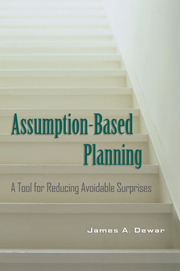Assumption-Based Planning
Unwelcome surprises in the life of any organization can often be traced to the failure of an assumption that the organization's leadership didn't anticipate or had "forgotten". Assumption-based planning (ABP) is a tool for identifying as many as possible assumptions underlying the plans of an organization and bringing them explicitly into the planning process. This book presents a variety of techniques for rooting out those vulnerable, crucial assumptions. It also presents steps for monitoring the vulnerable assumptions of a plan by taking actions to control them where possible and preparing for potential failure where control is not possible.
- Book ideal for MBA/master's/doctorate courses in business planning, strategic management
- Author internationally known in corporate, not-for-profit and US government circles
- Full of examples for business, non-military, and military applications
Reviews & endorsements
"...a careful but engaging explanation of how this type of planning works...Planners who use ABP can take comfort in its realism. The author and his associates have battle tested it in real-life planning for the U.S. Army and private clients over many years...The detailed knowledge gained in ABP should permit the development of ever more relevant scenarios for scenario planning and thus more robust plans." Futurist
"Essential for business managers and strategic planners interested in improving existing operation plans." The Futurist
Product details
January 2005Adobe eBook Reader
9780511007408
0 pages
0kg
19 b/w illus.
This ISBN is for an eBook version which is distributed on our behalf by a third party.
Table of Contents
- 1. The essence of assumption-based planning
- 2. A taxonomy of assumptions
- 3. Step 1: identifying assumptions
- 4. Step 2: identifying load-bearing, vulnerable assumptions
- 5. Step 3: identifying signposts
- 6. Step 4: developing shaping actions
- 7. Step 5: developing hedging actions
- 8. The art of conducting ABP
- 9. Beyond ABP as a post-planning tool.







